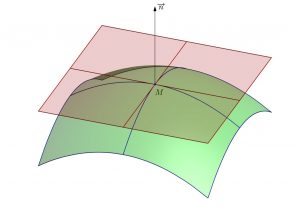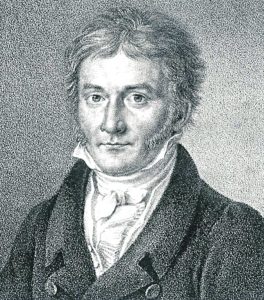
We can say that, until the beginning of the 19th century, a surface was seen and studied from the outside, as a two-dimensional object immersed in Euclidean three-dimensional space, like the envelope of a solid – that is precisely the first meaning of the word “surface” according to the dictionary of the Spanish Royal Academy: “Limit or boundary of a body, which separates it and distinguishes it from what is not it”. Associated with a surface point is the tangent plane and the normal vector, which determines the direction perpendicular to the tangent plane. According to the 18th century conception of surfaces, surface and tangent plane coincide in an infinitesimal environment of the point in question; on the other hand, the normal vector is projected perpendicular to this plane, and therefore to the surface. Thus, the normal vector is projected outside the surface, and thus certifies the existence of the three-dimensional space that contains the surface, and from which we observe and study it.
Gauss came to change this situation in 1827 with the publication of another of his great works: Disquisitiones generales circa superficies curvas.
What Gauss proposed was a view of the surface from within, intrinsically, as if we were two-dimensional beings living on it. This means that we can move on it in a combination of only two directions: up/down and left/right, and any other direction independent of these two is unknown to us; in particular, that of the normal vector – since this is projected outside the surface. By moving on a surface we can also measure distances on it. Gauss was interested in studying intrinsic properties of the surface, that is, in a very simplified form, geometrical properties of the surface that could be determined with the only information provided by living on it without the need to look at it from the outside – renouncing, therefore, the normal vector, which, being perpendicular to the surface, requires a dimension that is alien to the inhabitants of the surface. Gauss’s results showed that there is essential information about the surface that, despite needing the normal vector for its definition, could be calculated and known intrinsically -thereby renouncing to the normal vector-.
Funny enough, the inspiration for his theories came to Gauss while he was mule-riding through the Hanover region doing geodesic surveys; but it came to him slowly, unhurriedly, in small doses that he received during the ten long summers he devoted to his geodesic measurements. It was this careful measuring of distances in the gently undulating landscape of Lower Saxony that convinced him that juicy secrets of surface geometry were hidden there.
One of the usual ways in which 18th century mathematicians dealt with surfaces was by parameterisation.
$$x=x(u,v), y=y(u,v), z=z(u,v)$$
where \(u\) and \(v\) take values in a certain region of the plane. This expression allows us to know the three \((x,y,z)\) coordinates of each point on the surface; this assumes three coordinate axes outside the surface on which to measure the coordinates. In fact, from the parameterisation we can calculate, at each point, both the tangent plane and the normal vector. Gauss wanted to work not with this information – the surface seen from the outside – but with intrinsic information: how to measure distances on the surface. This is achieved by means of the so-called arc-length element
$$ds^2=dx^2+dy^2+dz^2,$$
in an analogous way to how the length of a plane curve is calculated.
Now, using the parametric equations of the surface we can write the arc element in the form
$$ds^2=E(u,v)du^2+2F(u,v)dudv+G(u,v)dv^2$$
where
$$E(u,v)=x_u^2+y_u^2+z_u^2,\quad F(u,v)=x_ux_v+y_uy_v+z_uz_v, \quad G(u,v)=x_v^2+y_v^2+z_v^2, $$
and \(x_u\) denotes the partial derivative of \(x=x(u,v)\) with respect to \(u\), and similarly with the rest.
This is Gauss’s starting point -what we know today as the first fundamental form-: what is important for him are the functions \(E, F\) and \(G\) that allow us to measure distances on the surface, and not the functions \(x, y, z\) that give the coordinates of the points on the surface.

Gauss then defined the (total) curvature of a surface at a point. He did this by comparing with the sphere of radius one: using the normal vector to the surface he unfolded pieces of it on the sphere. More precisely: given a point \(P\) on the surface, consider an environment \(U\), and at each point \(Q\) in that environment take the normal vector to the surface -normalised to length one-; translating each of these vectors to the centre of the sphere, we obtain a set of points \(n(U)\) on the sphere of radius one. Gauss compared the areas of \(n(U)\) and \(U\) by taking the quotient, and finally defined the curvature as the limit of that quotient when the environment \(U\) reduces to the point \(P\). Gauss then found the following analytic expression for the curvature:
$$k(u,v)=\frac{ L(u,v)N(u,v)-M^2(u,v)}{E(u,v)G(u,v)-F^2(u,v)},$$
where the functions \(L,M\) and \(N\) are defined by the determinants
$$L=\left\vert\begin{matrix}x_{uu}&y_{uu}&z_{uu}\\x_{u}&y_{u}&z_{u}\\x_{v}&y_{v}&z_{v}\end{matrix}\right\vert,\quad M=\left\vert\begin{matrix}x_{uv}&y_{uv}&z_{uv}\\x_{u}&y_{u}&z_{u}\\x_{v}&y_{v}&z_{v}\end{matrix}\right\vert,\quad N=\left\vert\begin{matrix}x_{vv}&y_{vv}&z_{vv}\\x_{u}&y_{u}&z_{u}\\x_{v}&y_{v}&z_{v}\end{matrix}\right\vert,$$
and are called functions of the second fundamental form.
Gauss also showed that this curvature is the product of the two principal curvatures studied by Euler, which shows that it is a reasonable measure of the curvature of a surface. The Euler curvatures at a point are those of the curves that are generated as the intersection of the surface and each of the planes that pass through the point and are perpendicular to the tangent plane; among other things, in 1760 Euler showed that these curvatures reach a maximum and a minimum – the so-called principal curvatures – and that the corresponding planes are perpendicular.
Gauss’s result is interesting, but unsatisfactory from the point of view of what Gauss intended, because obviously the curvature is a concept that has been defined from the normal vector and, therefore, it is not, from the outset, an intrinsic concept of the surface. In fact, the functions \(L, M\) and \(N\) are defined in terms of the \(x,y,z\) coordinates of the surface, and not of the intrinsic functions \(E,F,G\). Gauss was not deterred, and showed that, surprisingly, the curvature \(k(u,v)\) depends only on the \(E,F,G\) functions by the formula
$$k=\frac{1}{2H}\left[\left(\frac{FE_v}{EH}-\frac{G_u}{H}\right)_u+\left(\frac{2F_u-E_v}{H}-\frac{FE_u}{EH}\right)_v\right]$$
and, as before, the subscript \(u\) denotes the partial derivative of the corresponding function with respect to \(u\). That is, although the definition of curvature itself uses the normal vector deterministically, which is the same as saying how the surface is immersed in three-dimensional space, the curvature is an intrinsic property that could be calculated by the inhabitants living on it – despite not being able to perceive the dimension in which the normal vector is projected. Gauss found this result so impressive that he called it the Theorema Egregium, or “egregious theorem”. In particular, the theorem implies that if the variables \(u\) and \(v\) are modified isometrically, that is, by establishing a bijection that leaves invariant the arc length element, the curvature of the new surface does not change. Thus, if we fold a surface, without shrinking or dilating it, it will have the same curvature as the original one; which is an extremely surprising fact: since a sheet of paper -a plane- has zero curvature, any surface obtained by crumpling a sheet of paper will have, strange as it may seem, zero curvature. It also follows from Gauss’s result that a sphere – which has constant positive curvature – cannot be represented on a plane – which has zero curvature – in a way that preserves distances, and therefore it is impossible to map the surface of the Earth with that property.
References
Antonio J. Durán, Crónicas matemáticas, Crítica, Barcelona, 2018.

Leave a Reply